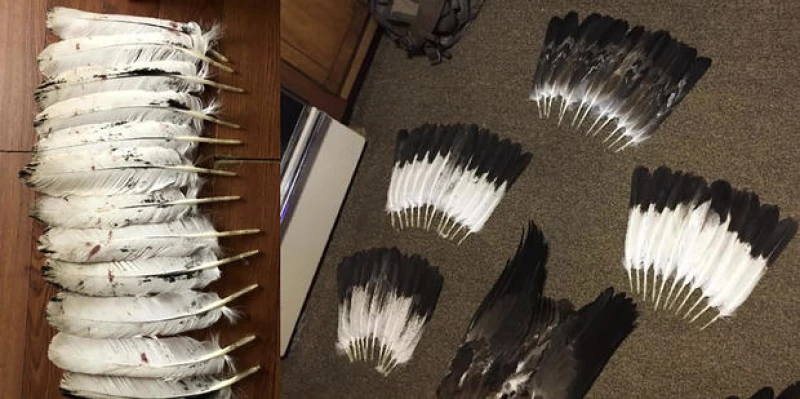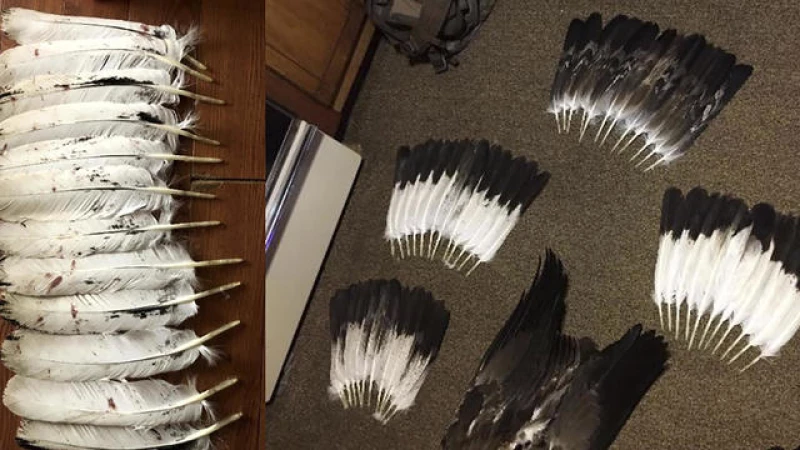A man from Washington state is set to plead guilty on Wednesday for his involvement in the killing of thousands of birds, specifically eagles, on an American Indian reservation in Montana. He then proceeded to sell their feathers and body parts on the black market.
This prosecution regarding the illegal killing of golden and bald eagles on the Flathead Indian Reservation highlights the ongoing issue of a flourishing illegal trade in eagle feathers, despite law enforcement efforts to crack down on such activities in the 2010s, resulting in numerous criminal indictments across the Western and Midwestern regions of the United States.
An indictment from a grand jury in December cited the defendant, Travis John Branson, who allegedly mentioned in a text from January 2021 his intention to go on a "killing spree" to acquire eagle tails. Branson, along with another defendant named Simon Paul, were responsible for the deaths of around 3,600 birds, including eagles on the Flathead reservation and other locations, as stated in the indictment. The federal authorities have not disclosed the methods used to kill the birds or the exact locations of the other incidents.

Branson, a resident of Cusick, Washington, reportedly sold two sets of golden eagle tail feathers - highly valued by many Native American tribes - to an undisclosed buyer for $650 in March 2021, according to court records.
Less than two weeks later, law enforcement stopped Branson on the reservation and found in his vehicle the feet and feathers of a golden eagle he had shot near Polson, Montana, according to filings that included a photo of the bird's severed feet with their massive talons. The bird's carcass had been "cleaned" by the second defendant, Simon Paul, and was found in a nearby field, prosecutors wrote.
Multiple phones seized by authorities during the stop yielded photos and text messages that described "the shooting, killing and ultimate selling of bald and golden eagles throughout the United States," prosecutors said.
Feathers and other parts of eagles are illegal to sell but widely used by Native Americans in ceremonies and during powwows.
Branson, who remained free following the indictment, reached a deal with prosecutors last month to plead guilty to four counts: conspiracy, wildlife trafficking and two counts of trafficking in federally protected bald and golden eagles.
Branson could not be reached for comment before Wednesday's hearing in Missoula. His public defender declined comment while the case is pending.
Paul of St. Ignatius, Montana, remains at large. A federal judge issued an arrest warrant for Paul when he did not show up for an initial court hearing in December.
The indictment described Branson and Paul trafficking golden and bald eagles or their parts on at least 11 occasions between December 2020 and the stop of Branson by law enforcement on March 13, 2021.
Recent court documents reveal that the illicit activities extended far beyond what was initially known. The scheme, dating back to 2015, implicated other individuals who participated in the killing of eagles on the Flathead Reservation, although their identities remain undisclosed.
One incriminating 2016 text message cited by prosecutors shows Branson seemingly admitting that shipping eagles internationally was against the law, stating, "I just get em for 99 cents...price of a bullet."
During another text conversation, Branson was allegedly involved in a negotiation for the sale of eagle feathers, where he remarked, "I don't get em for free though....out hear (sic) committing felonies," as per the court filings.
The indictment further claims that on March 13, 2021, Branson and Paul revisited a site where a deer had been previously killed to attract eagles. Subsequently, Branson shot a golden eagle, which Paul proceeded to clean. Both individuals then collected various parts of the golden eagle and stored them in a vehicle for transportation, as stated by prosecutors.
Branson could potentially face a maximum of five years in prison and a $250,000 fine for the most severe charge of conspiracy. As part of a plea agreement, the U.S. Attorney's Office in Montana has indicated their intention to drop additional trafficking charges and recommend a reduction in sentencing guidelines that could mitigate the severity of Branson's punishment.
The criminal case comes almost a decade after a multi-state U.S. Fish and Wildlife Service trafficking investigation dubbed "Operation Dakota Flyer" led to charges against 35 defendants and the recovery of more than 150 eagles, 100 hawks and owls and 20 species of other protected birds that were seized or bought by authorities in undercover purchases, according to federal officials.
Federally recognized tribes can apply for permits with the U.S. Fish and Wildlife Service to take a bald or golden eagle for religious purposes, and enrolled tribal members can apply for feathers and other bird parts from the National Eagle Repository in Colorado and non-government repositories in Oklahoma and Phoenix. There's a yearslong backlog of requests at the National Repository and researchers say the high demand is fueling the black market for eagle parts.
The Bald and Golden Eagle Protection Act was enacted in 1940 to protect the bald eagle. In 1962, Congress extended the Act to protect golden eagles.
Bald eagles were decimated by habitat destruction and degradation in the mid 1900s and in danger of going exctinct, but in recent decades, habitat protection and conservation actions have "helped bald eagles make a remarkable recovery," the Fish and Wildlife Service says. There are more than 316,000 bald eagles in the lower 48 states, based on data from 2018 to 2019.
They can live up to about 30 years in the wild.







